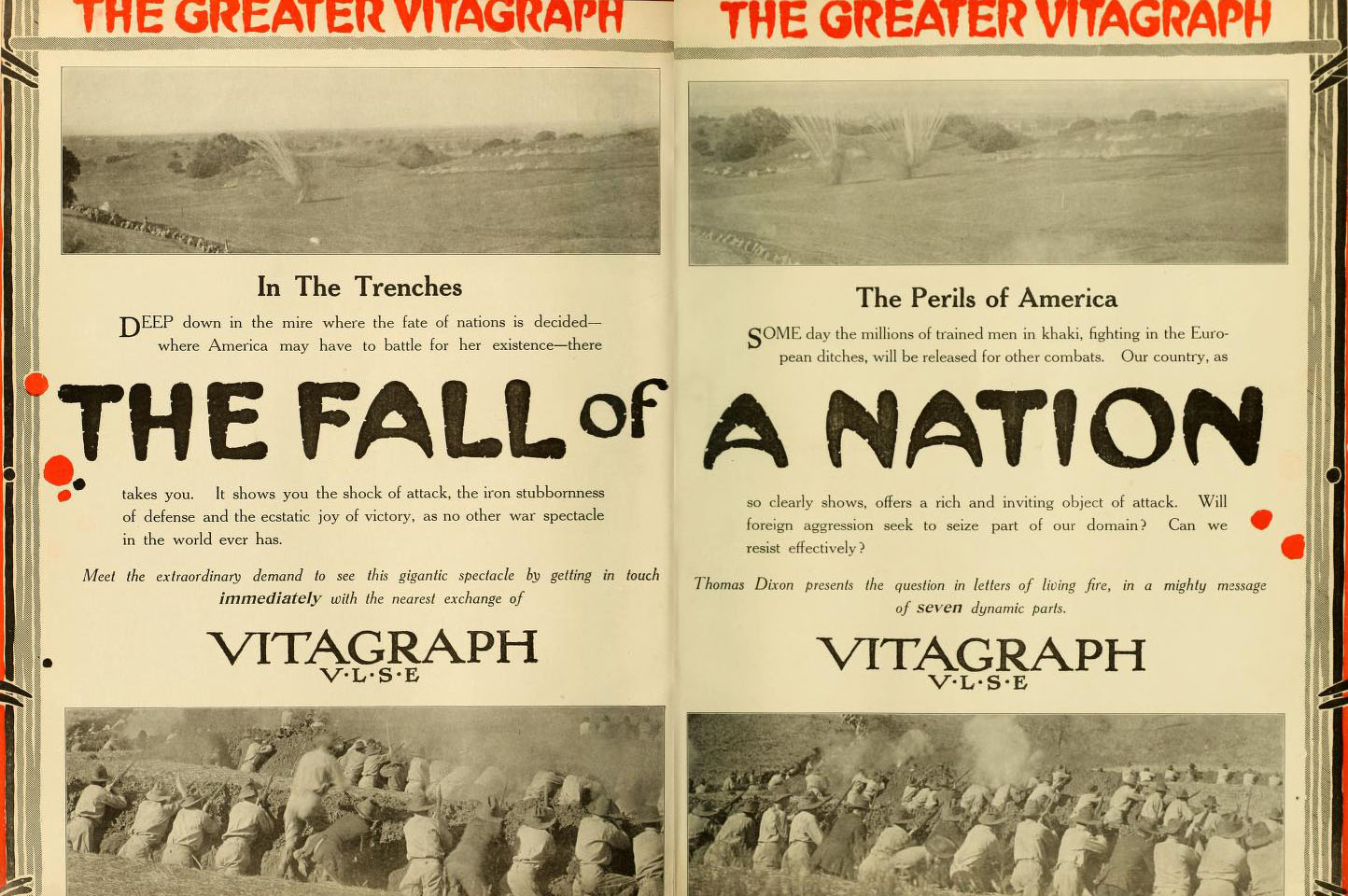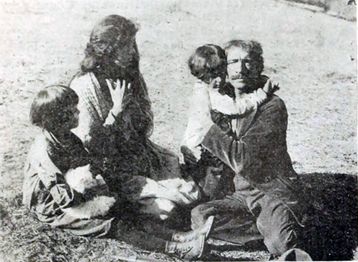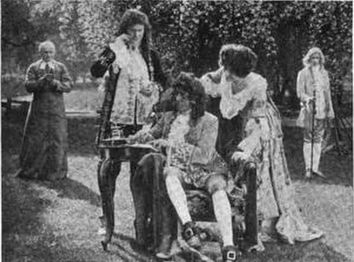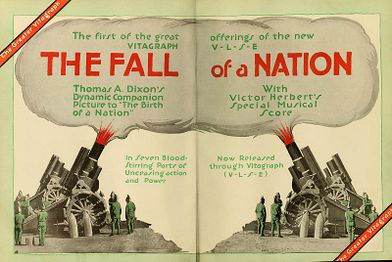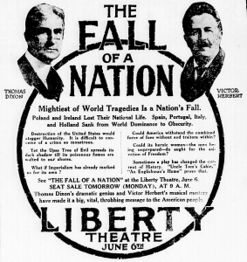The Fall of a Nation (lost sequel film to "The Birth of a Nation"; 1916): Difference between revisions
mNo edit summary |
No edit summary |
||
| (10 intermediate revisions by 6 users not shown) | |||
| Line 4: | Line 4: | ||
|imagecaption=Advertisement for the film. | |imagecaption=Advertisement for the film. | ||
|status=<span style="color:red;">'''Lost'''</span> | |status=<span style="color:red;">'''Lost'''</span> | ||
}} | }} | ||
After the release of D.W. Griffith’s controversial 1915 film ''The Birth of a Nation'', several attempts were made to capitalize on and respond to its success. One of these came from Thomas Dixon Jr., author of ''The Clansman'', the novel on which the original film was based. Released in 1916, Dixon’s film was titled '''''The Fall of a Nation''''', and was adapted from his novel of the same name. The movie, often thought to be the first film sequel ever made, is now considered a lost film.<ref>[http://birthmoviesdeath.com/2015/04/10/fall-of-a-nation-hollywoods-first-sequel Article on the movie from Birth. Movies. Death.] Retrieved 20 Nov '16</ref> | |||
After the release of D.W. Griffith’s controversial 1915 film ''The Birth of a Nation'', several attempts were made to | |||
==Plot== | ==Plot== | ||
The film was based on the same ideology as ''Birth of a Nation'', advocating white supremacy and preparedness for war. However, while ''Birth'' was a | The film was based on the same ideology as ''Birth of a Nation'', advocating white supremacy and preparedness for war. However, while ''Birth'' was a dramatized version of the real-life events of the Civil War and Reconstruction, ''Fall'' instead focuses on a hypothetical future where the United States’ pacifism nearly leads to its downfall.<ref>[https://is.gd/VhfxH9 Google Books excerpt of ''Film Sequels: Theory and Practice from Hollywood to Bollywood'', by Carolyn Jess-Cooke.] Retrieved 20 Nov '16</ref> | ||
The story begins after the sinking of the Lusitania, as an American millionaire named Charles Waldron assists a German conspiracy to overthrow the American government.<ref>[http://query.nytimes.com/gst/abstract.html?res=9D06E1D6163BE633A25754C0A9609C946796D6CF&legacy=true# New York Times review of the film] Retrieved 20 Nov '16 | The story begins after the sinking of the Lusitania, as an American millionaire named Charles Waldron assists a German conspiracy to overthrow the American government.<ref>[http://query.nytimes.com/gst/abstract.html?res=9D06E1D6163BE633A25754C0A9609C946796D6CF&legacy=true# New York Times review of the film.] Retrieved 20 Nov '16</ref> A large German force, known as the European Confederated Army, invades the country and begins executing citizens. The United States is caught unprepared for the brutal assault, with pacifists having thought that the country had no enemies. This allows the Germans to conquer the nation, as Charles designates himself the new prince.<ref>[http://www.tcm.com/tcmdb/title/553036/The-Fall-of-a-Nation/ Turner Classic Movies page for the film.] Retrieved 20 Nov '16</ref> | ||
After a section that portrays what America is like under German rule, a suffragette named Virginia Holland | After a section that portrays what America is like under German rule, a suffragette named Virginia Holland organizes a rebel army. Known as the Daughters of Jael, the army members revolt against the occupying soldiers and restore the country back to its former rule. Virginia then makes plans to marry Congressman John Vassar, who assisted her with her army and had previously lobbied for increased military preparedness. | ||
The film is split into three acts: | The film is split into three acts: "A nation falls", "The heel of the conqueror", and "The uprising two years later". | ||
==Production== | ==Production== | ||
The movie was written and directed by Dixon and was released through his production company, Dixon Studios. The film starred Lorraine Huling and Percy Standing as Virginia and Charles, respectively. Other cast members include Arthur Shirley (as John Vassar), Flora MacDonald, Paul Willis, Philip Gastrock, and C. H. Geldart. | The movie was written and directed by Dixon, and was released through his production company, Dixon Studios. The film starred Lorraine Huling and Percy Standing as Virginia and Charles, respectively. Other cast members include Arthur Shirley (as John Vassar), Flora MacDonald, Paul Willis, Philip Gastrock, and C. H. Geldart. | ||
In an effort to link it to the events of ''The Birth of a Nation'', Dixon returned to the same locations present in Birth in order to film many of the battle scenes. The soundtrack was composed by Victor Herbert, and is considered by Encyclopædia Britannica to be “the first original symphonic score composed for a feature film.”<ref>[https://www.britannica.com/biography/Victor-Herbert Encyclopædia Britannica article on Victor Herbert] Retrieved 20 Nov '16 | In an effort to link it to the events of ''The Birth of a Nation'', Dixon returned to the same locations present in ''Birth'' in order to film many of the battle scenes. The soundtrack was composed by Victor Herbert, and is considered by Encyclopædia Britannica to be “the first original symphonic score composed for a feature film.”<ref>[https://www.britannica.com/biography/Victor-Herbert Encyclopædia Britannica article on Victor Herbert.] Retrieved 20 Nov '16</ref> | ||
==Availability== | ==Availability== | ||
Unlike its predecessor, ''The Fall of a Nation'' was not a commercial or critical success, and was the sole film Dixon Studios produced before collapsing in 1921. As such, it was not widely preserved, and no copies are known to exist. The novel it was adapted from has survived throughout the years, but as for the movie itself, all that exists today are a number of stills and the soundtrack, the latter of which is held in the possession of the Library of Congress.<ref>[http://www.filmsite.org/1916-filmhistory.html 1916 timeline from AMC Filmsite] Retrieved 20 Nov '16 | Unlike its predecessor, ''The Fall of a Nation'' was not a commercial or critical success, and was the sole film Dixon Studios produced before collapsing in 1921. As such, it was not widely preserved, and no copies are known to exist. The novel it was adapted from has survived throughout the years, but as for the movie itself, all that exists today are a number of stills and the soundtrack, the latter of which is held in the possession of the Library of Congress.<ref>[http://www.filmsite.org/1916-filmhistory.html 1916 timeline from AMC Filmsite.] Retrieved 20 Nov '16</ref> | ||
==Gallery== | ==Gallery== | ||
===Stills=== | |||
<gallery mode=packed heights=175px> | <gallery mode=packed heights=175px> | ||
File:Fallofanation1.jpg | File:Fallofanation1.jpg | ||
File:Fallofanation2.jpg | File:Fallofanation2.jpg | ||
File:Fallofanation3.jpg | File:Fallofanation3.jpg | ||
</gallery> | |||
===Advertisements=== | |||
<gallery mode=packed heights=175px> | |||
File:Fall Advertisement.jpg | |||
File:Fall Advertisement 2.jpg | |||
</gallery> | </gallery> | ||
==External Link== | |||
*[http://www.imdb.com/title/tt0006664/ IMDb page for ''The Fall of a Nation''.] Retrieved 20 Nov '16 | |||
==References== | ==References== | ||
{{reflist}} | |||
[[Category:Lost films|Fall of a Nation | [[Category:Lost films|Fall of a Nation]] | ||
[[Category:Historic|Fall of a Nation | [[Category:Historic|Fall of a Nation]] | ||
[[Category:Completely lost media|Fall of a Nation]] | |||
Latest revision as of 22:09, 7 May 2020
After the release of D.W. Griffith’s controversial 1915 film The Birth of a Nation, several attempts were made to capitalize on and respond to its success. One of these came from Thomas Dixon Jr., author of The Clansman, the novel on which the original film was based. Released in 1916, Dixon’s film was titled The Fall of a Nation, and was adapted from his novel of the same name. The movie, often thought to be the first film sequel ever made, is now considered a lost film.[1]
Plot
The film was based on the same ideology as Birth of a Nation, advocating white supremacy and preparedness for war. However, while Birth was a dramatized version of the real-life events of the Civil War and Reconstruction, Fall instead focuses on a hypothetical future where the United States’ pacifism nearly leads to its downfall.[2]
The story begins after the sinking of the Lusitania, as an American millionaire named Charles Waldron assists a German conspiracy to overthrow the American government.[3] A large German force, known as the European Confederated Army, invades the country and begins executing citizens. The United States is caught unprepared for the brutal assault, with pacifists having thought that the country had no enemies. This allows the Germans to conquer the nation, as Charles designates himself the new prince.[4]
After a section that portrays what America is like under German rule, a suffragette named Virginia Holland organizes a rebel army. Known as the Daughters of Jael, the army members revolt against the occupying soldiers and restore the country back to its former rule. Virginia then makes plans to marry Congressman John Vassar, who assisted her with her army and had previously lobbied for increased military preparedness.
The film is split into three acts: "A nation falls", "The heel of the conqueror", and "The uprising two years later".
Production
The movie was written and directed by Dixon, and was released through his production company, Dixon Studios. The film starred Lorraine Huling and Percy Standing as Virginia and Charles, respectively. Other cast members include Arthur Shirley (as John Vassar), Flora MacDonald, Paul Willis, Philip Gastrock, and C. H. Geldart.
In an effort to link it to the events of The Birth of a Nation, Dixon returned to the same locations present in Birth in order to film many of the battle scenes. The soundtrack was composed by Victor Herbert, and is considered by Encyclopædia Britannica to be “the first original symphonic score composed for a feature film.”[5]
Availability
Unlike its predecessor, The Fall of a Nation was not a commercial or critical success, and was the sole film Dixon Studios produced before collapsing in 1921. As such, it was not widely preserved, and no copies are known to exist. The novel it was adapted from has survived throughout the years, but as for the movie itself, all that exists today are a number of stills and the soundtrack, the latter of which is held in the possession of the Library of Congress.[6]
Gallery
Stills
Advertisements
External Link
- IMDb page for The Fall of a Nation. Retrieved 20 Nov '16
References
- ↑ Article on the movie from Birth. Movies. Death. Retrieved 20 Nov '16
- ↑ Google Books excerpt of Film Sequels: Theory and Practice from Hollywood to Bollywood, by Carolyn Jess-Cooke. Retrieved 20 Nov '16
- ↑ New York Times review of the film. Retrieved 20 Nov '16
- ↑ Turner Classic Movies page for the film. Retrieved 20 Nov '16
- ↑ Encyclopædia Britannica article on Victor Herbert. Retrieved 20 Nov '16
- ↑ 1916 timeline from AMC Filmsite. Retrieved 20 Nov '16
